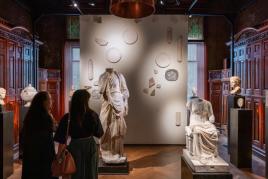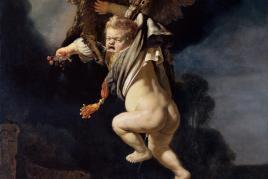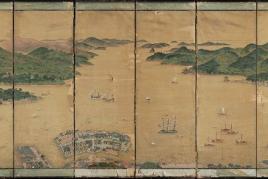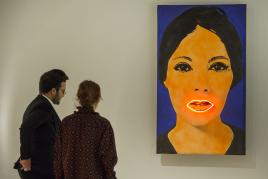FENIX acquires two rare paintings for collection at TEFAF
 Jan Adriaensz van Staveren - Mit freundlicher Genehmigung von: findart
Jan Adriaensz van Staveren - Mit freundlicher Genehmigung von: findartWer: findart
Was: Presse
Wann: 18.03.2023
Wo: Maastricht, Niederlande
The exhibition held at the Rembrandthuis in 2020 made it clear that the slave trade in Rembrandt’s time, the early 17th century, had not yet reached the scale it would later take on. Slavery was prohibited in the Republic of the Netherlands and only happened in the colonies. It was precisely during this phase that Dutch masters like Jan van Staveren started painting from life and depicting everything as realistically as possible. This combination created a brief period in European art history when people of colour were portrayed realistically and as the main subject. Only later do the pages and black servants appear, rendered as status symbols and accessories. In the 19th century, black models were often depicted as negative stereotypes.
Leiden or AmsterdamIn the 17th century, the population of cities grew massively due to migration from the Southern Netherlands and elsewhere. The Republic, with a reputation for tolerance, attracted various communities, including Sephardic Jews, but also workers from Scandinavia and northern Germany and free sailors. It is not known whether Van Staveren found these models in Leiden or instead in Amsterdam. He likely visited Rembrandt’s studio during a stay in Amsterdam. In May 1639, Rembrandt had moved into a wealthy house with workshop on Sint Anthoniebreestraat (now the Rembrandthuis). There were Sephardic Jews living nearby, some of whom had brought their African servants with them. The Amsterdam City Archive, with registers of marriage licences from the late 16th century onwards, has the address details. The earliest inhabitants of colour in the capital, often free sailors or freed slaves formed a close-knit group estimated to number 100-200 people around 1650, out of a city population of around 200,000. Such a significant black community was not unique to Amsterdam, but was also known in Leiden in the early 17th century. The cities in Holland had a very large migrant population. In 1622, a third of Amsterdam was a migrant, and in Leiden more than half. The two Van Staveren portraits give a face to migration as a timeless phenomenon and that is the reason they have been acquired for the FENIX collection.
Jan van StaverenJan van Staveren produced mostly small paintings with a high standard of finish, and was a so-called ‘Leiden Fijnschilder’ of biblical scenes, allegorical subjects, genre scenes, portraits, animals and landscapes. He also specialised in tronies, such as these two small panels. Jan van Staveren followed in his father’s footsteps in holding administrative functions and, like his father, rose to the position of mayor in 1667. Van Staveren was among the first members of the Leiden Guild of St. Luke and paid dues until his death. He spent his whole life in Leiden, never married and died a rich man. The provenance of both paintings can be traced back to his own collection and that of his sister (Alida van Staveren). Both paintings came into the possession of French aristocracy in the 18th century and were then taken into Swiss and French private collections until 2022. At TEFAF, both works were offered by art dealer Bob Haboldt.
FENIXFENIX will open in late 2024 in a historic harbour warehouse dating from 1923, to a design by Chinese architect Ma Yansong, founder of MAD Architects. FENIX will provide space for cultural, culinary and creative encounters, at the quintessential location of departure and arrival. Where millions of people departed or arrived from all over the world. Fleeing or chasing after love. Looking for happiness or better opportunities. FENIX will tell these stories and show that migration is a timeless and universal phenomenon. Future visitors will enter the museum through a carefully restored warehouse via a theatrical double-helix staircase that ends high above the building in a spectacular platform that provides a panorama over the River Maas and a new perspective on the city of Rotterdam and the world.
FENIX is an initiative by the Droom en Daad Foundation.
Jan Adriaensz van StaverenLeiden 1613/14-1669 LeidenA set of tronies of a young man of African origin in oriental costume and a young man of African origin wearing a yellow feathered beret, circa 1640-43Oil painting on panel (oval); 15.5 x 12 cmFENIX Collection, Rotterdam
ProvenanceProbably the artist’s own collection, Leiden;His sister Alida van Staveren (1626-69), Leiden;Her husband Eduardus Westerneyn (1632-1674), Maredorp in Leiden;Collection of Leopold (Rambald Adolph) Graf von Collalto (1674-1707) or his half-brother August Joachim Graf von SinzendorfCollection of the De Sturler family, probably Bern;Private collection, France, until 2022.
.
 Jan Adriaensz van Staveren - Mit freundlicher Genehmigung von: findart
Jan Adriaensz van Staveren - Mit freundlicher Genehmigung von: findartCopyright © 2024 findART.cc - All rights reserved







